ArcGIS Urban has three user interfaces (UIs): the overview, the experience to view plans and projects, and the experience to edit plans and projects.
Note:
Urban has two UI appearance modes: light and dark. Click the user button at the upper right of the app to change the mode.
Overview user interface
The overview is a complete view of all plans, projects, and indicators in a city. The overview UI contains the following key elements:
- The view—A 3D model of a city with plans and projects represented by multicolored buildings, study areas, and pins. Hover over a pin to get more details about the plan or project.
- The search panel—An interactive side panel with search and filter functionality with a list of plans, projects, and indicators.
The overview is the first thing you see after starting ArcGIS Urban. Depending on your permissions, the overview can be either read-only or the starting point for creating and editing plans, projects, and indicators. As an administrator, you can configure Urban using the data manager in the overview.
The following images show the overview UI (with and without editing permissions):
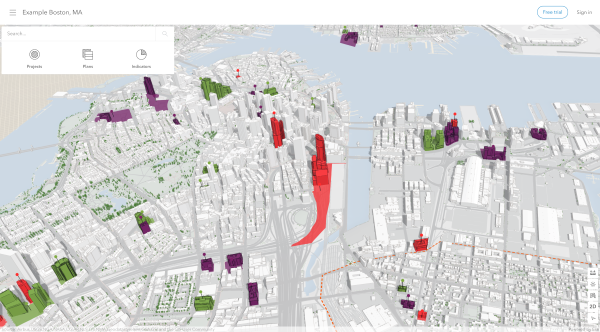
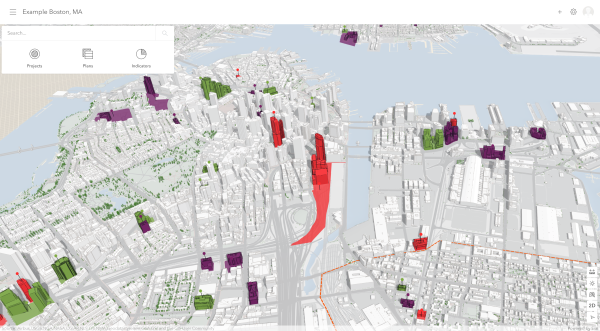
Plan and project viewing experience
The viewing experience is available to users who don't have an Urban license assigned. To view a plan or a project, use the search panel or click the corresponding location pin in the overview. Click the Return to overview button  to close the viewing experience and go back to the overview.
to close the viewing experience and go back to the overview.
Plan viewing experience
A user who is not signed in can perform the followings actions in a publicly shared plan:
- View the plan info.
- Switch between scenarios.
- Review the content on the map including future buildings.
- Open the zoning mode and view the boundaries, legend, and numbers.
- Open the development mode and view the colored spaces, legend, and numbers.
- Open the dashboard and view numbers and charts.
- Switch on and off layers.
- Use viewpoints for navigation.
- Adjust and animate shadows in the daylight tool.
- Measure distances and areas, and slice through objects.
- Take a screenshot.
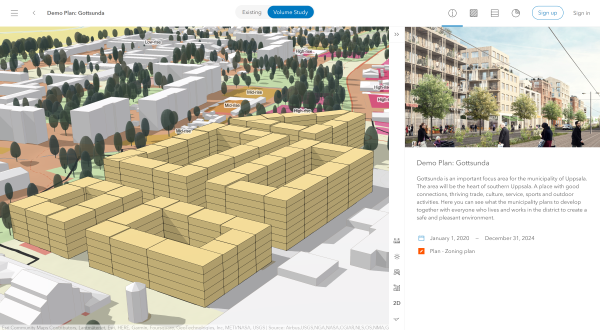
Project viewing experience
A user who is not signed in can perform the following actions in a publicly shared project:
- View the project info and status.
- Switch between scenarios.
- Review the content on the map including 3D models.
- Review metrics in the dashboard (if they are configured).
- Switch on and off layers.
- Adjust and animate shadows in the daylight tool.
- Use viewpoints to navigate to camera positions (if they are configured).
- Use the 3D navigation tools.
- Take a screenshot.
- Access the help menu.
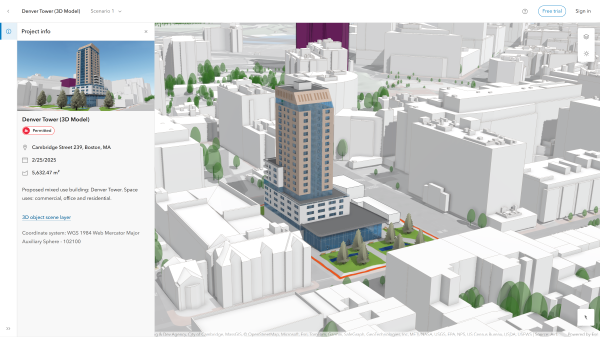
Plan and project editing experience
The editing experience is available to users with an Urban license. The editing experience allows you to view and edit the content of a plan or a project if you have the appropriate permissions. See Workflow accessibility for details. To edit a plan or a project, use the search panel or click the corresponding location pin in the overview. Click the Return to overview button  to close the editing experience and go back to the overview.
to close the editing experience and go back to the overview.
Plan editing experience
While editing a plan, the UI is divided into the following modes, which are displayed to the right of the header:
- Details
 —View a thumbnail image, the plan description, the start and end date of the plan, and edit the study area.
—View a thumbnail image, the plan description, the start and end date of the plan, and edit the study area. - Zoning or land use
 —Edit and configure zoning or land use (depending on the type of plan you are editing), overlays, and parcel overrides.
—Edit and configure zoning or land use (depending on the type of plan you are editing), overlays, and parcel overrides. - Development
 —Edit parcel geometries, apply building types, generate buildings, design and edit spaces, demolish parcels, and assess parcel suitability.
—Edit parcel geometries, apply building types, generate buildings, design and edit spaces, demolish parcels, and assess parcel suitability. - Analysis
 —View analysis tools and a list of already conducted analyses.
—View analysis tools and a list of already conducted analyses. - Dashboard
 —View metrics for the scenario. Change chart types and arrange metrics on the dashboard.
—View metrics for the scenario. Change chart types and arrange metrics on the dashboard. - Discussion
 —Review and comment on the design in user groups and view public feedback.
—Review and comment on the design in user groups and view public feedback.

The numbered plan editing experience UI items are described in the following table:
| UI item | Description |
|---|---|
1—Menu button | Open and close the layer side panel. |
2—Return to overview | Close the plan editor and go to the overview. |
3—Plan options | Export a scenario to a web scene, save the plan as a duplicate, share the plan, or access the plan configuration. |
4—Scenario switcher | Switch between scenarios and access the Scenarios dialog box to add and configure scenarios. |
5—Undo and redo | Undo and redo changes. |
6—Help menu | Access to a variety of resources about ArcGIS Urban such as the product documentation and what's new blog posts. |
7—Details mode | Open the side panel to view a thumbnail image, read the plan description, see the start and end date of the plan, and edit the study area. |
8—Zoning mode | Open the side panel to edit and configure zoning, overlays, and parcel overrides. In a land-use plan, the option is Land Use. |
9—Development mode | Open the side panel to develop parcels and edit spaces. |
10—Analysis mode | Open the side panel to analyze the impact of a plan. |
11—Dashboard mode | Open the side panel to show and edit the dashboard with its metrics. |
12—Discussion mode | Open the side panel to review and comment on the design in user groups and to see public feedback. |
13—Sign-in button | Sign in or out and switch accounts. |
14—Expand button | Expand and collapse the side panel. |
15—Workflow toolbar | Use tools based on the active mode. |
16—View toolbar | Use tools to adjust, navigate, and analyze the view. |
17—Context layers | Turn layers on or off. This list is only available if you have added context to the plan or scenario. |
18—Design layers | Turn layers on or off. |
19—Basemaps | Switch between basemap views. |
Project editing experience
While editing a project, the UI is separated into four modes on the left side of the view:
- Info
 —View a thumbnail image, the project description, status, the start and end date of the project, the coordinate system, and more.
—View a thumbnail image, the project description, status, the start and end date of the project, the coordinate system, and more. - Development
 —Upload a 3D model and add building volumes, assets, and surfaces.
—Upload a 3D model and add building volumes, assets, and surfaces. - Analysis
 —View analysis tools and a list of already conducted analyses.
—View analysis tools and a list of already conducted analyses. - Discussion
 —Review and comment on the design in user groups.
—Review and comment on the design in user groups.
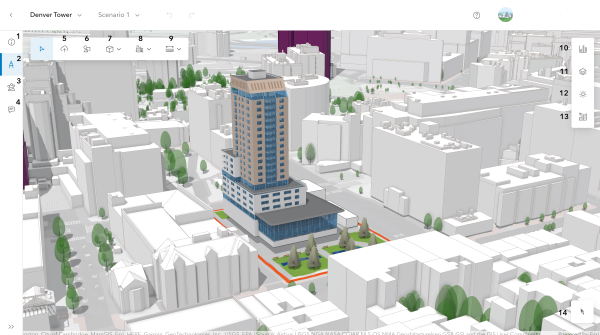
The numbered project editing experience UI items are described in the following table:
| UI item | Description |
|---|---|
1—Info mode | Open the side panel to view a thumbnail image, read the project description, and see the start and end date of the project. |
2—Development mode | Open the side panel to upload 3D models and add building volumes, assets, and surfaces. |
3—Analysis mode | Open the side panel to analyze the impact of a project. |
4—Discussion mode | Open the side panel to review and comment on the design in user groups. |
5—Upload | Select a file to upload a 3D model or an image. |
6—Assets | Choose from a variety of trees, vehicles, and furniture to place on the map. |
7—Volumes and surfaces | Draw buildings and surfaces to visualize the ground. |
8—Demolish | Remove what is currently within the project boundary. |
9—Measure tools | Measure distances and areas and slice through objects. |
10—Details | Explore the underlying zoning, land use, and parcel data when an envelope is selected. |
11—Dashboard | Show and edit the dashboard with its metrics. |
12—Layers | Turn on and off layers and switch the visualization mode. |
13—Daylight | Adjust and animate shadows. |
14—Viewpoints | Add, edit, and use camera viewpoints to navigate in the scene. |
15—3D Navigation | Navigate in the scene, take screenshots, and zoom to the study area. |